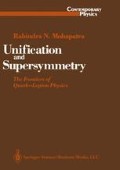Abstract
Ultimate unification of all particles and all interactions is the eternal dream of theoretical physicists. The unified gauge theories have taken us a step closer to realizing the second goal. However, since known “elementary” particles consist of both fermions (q, l) and bosons (photons γ, W, Z color octet of gluons) their ultimate unification would require them either to be composites of some basic set of fermions which can be unified within a Lie group framework or that there must exist a new symmetry that transforms bosons to fermions. In this chapter, we begin discussion of this latter kind of symmetry [1], known as supersymmetry. Supersymmetry was invented in 1973 by Wess and Zumino [2] and earlier in a nonlinear realization by Volkov and Akulov [3].
Access this chapter
Tax calculation will be finalised at checkout
Purchases are for personal use only
Preview
Unable to display preview. Download preview PDF.
References
For excellent reviews see
A. Salam and J. Strathdee, Fortschr Phys, 26, 57 (1978);
P. van Niuwenhuizen, Phys. Rep. 68, 189 (1981);
P. Fayet and S. Ferrara, Phys. Rep. 32, 249 (1977);
S. J. Gates, M. T. Grisaru, M. Rocek, and W. Siegel, Superspace, Benjamin Cummings, New York 1983;
J. Wess and J. Bagger, Introduction to Super symmetry, Princeton University Press, Princeton, NJ, 1983;
Some more recent reviews are
H. P. Nilles, Phys. Rep. 110, 1 (1984);
H. Haber and G. Kane, Phys. Rep. 117, 76 (1984);
A. Chamseddin, P. Nath, and R. Arnowitt, Applied N = 1 Supergravity, World Scientific, Singapore, 1984;
B. Ovrut, Lecture Notes by S. Kalara and M. Yamawaki, 1982.
J. Wess and B. Zumino, Nucl. Phys. B70, 39 (1974);
J. Wess and B. Zumino, Phys. Lett. 49B, 52 (1974).
D. Volkov and V. P. Akulov, JETP Lett. 16, 438 (1972).
A. Salam and J. Strathdee, Nucl. Phys. B76, 477 (1974);
A. Salam and J. Strathdee, Phys. Lett. 51B, 353 (1974).
Author information
Authors and Affiliations
Rights and permissions
Copyright information
© 1986 Springer Science+Business Media New York
About this chapter
Cite this chapter
Mohapatra, R.N. (1986). Global Supersymmetry. In: Unification and Supersymmetry. Contemporary Physics. Springer, New York, NY. https://doi.org/10.1007/978-1-4757-1928-4_9
Download citation
DOI: https://doi.org/10.1007/978-1-4757-1928-4_9
Publisher Name: Springer, New York, NY
Print ISBN: 978-1-4757-1930-7
Online ISBN: 978-1-4757-1928-4
eBook Packages: Springer Book Archive

